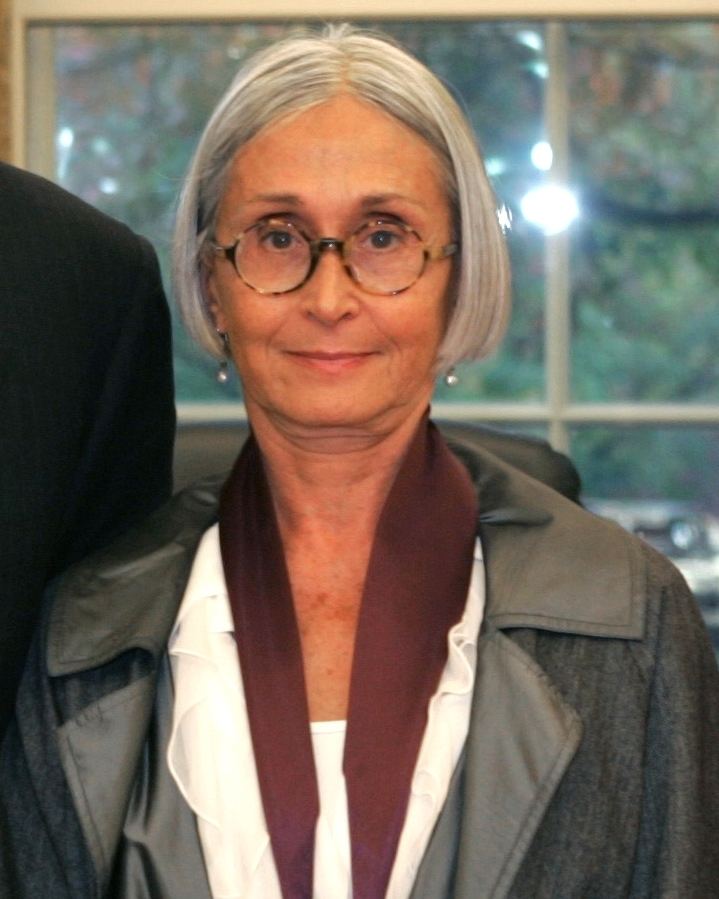Occupation Choreographer, dancer Role Dancer · twylatharp.org Years active 1960s–present Children Jesse Huot | Website www.TwylaTharp.org Name Twyla Tharp | |
 | ||
Books Push Comes to Shove, The Youth Habit, Firebrand Test (Italian) Movies The Catherine Wheel: Twyla Tharp Dance Foundation, Zorns Lemma, The Catherine Wheel Similar People | ||
The creative habit by twyla tharp
Twyla Tharp (; born July 1, 1941) is an American dancer, choreographer, and author who lives and works in New York City. In 1966, she formed her own company Twyla Tharp Dance. Her work often uses classical music, jazz, and contemporary pop music.
Contents
- The creative habit by twyla tharp
- Joffrey mavericks of american dance official trailer
- Early years
- Dances and ballets
- Broadway
- Film television and print
- Collaborative work
- Film
- Video
- Television
- Books
- Honors and awards
- Personal life
- References

From 1971 to 1988, Twyla Tharp Dance toured extensively around the world, performing original works. In 1973, Tharp choreographed Deuce Coupe to the music of The Beach Boys for the Joffrey Ballet. Deuce Coupe is considered to be the first crossover ballet. Later she choreographed Push Comes to Shove (1976), which featured Mikhail Baryshnikov and is now thought to be the best example of the crossover ballet.

In 1988, Twyla Tharp Dance merged with American Ballet Theatre, since which time ABT has held the world premieres of 16 of Tharp's works.

Joffrey mavericks of american dance official trailer
Early years
Tharp was born in 1941 on a farm in Portland, Indiana, the daughter of Lucille and William Tharp. She was named for Twila Thornburg, the "Pig Princess" of the 89th Annual Muncie Fair in Indiana as related in her own book The Creative Habit: Learn It and Use It for Life (2007).
As a young child, Tharp spent a few months each year living with her Quaker grandparents on their farm in Indiana. Her mother insisted she take lessons in dance (ballet, tap, jazz, and modern), and piano, drum, viola, violin, shorthand, German, and French. In 1950, Tharp's family—younger sister Twanette, twin brothers Stanley and Stanford, and her parents—moved to Rialto, California. Her parents opened a drive-in movie theater, where Tharp worked. The drive-in was on the corner of Acacia and Foothill, the major east–west artery in Rialto and the path of Route 66. She attended Pacific High School in San Bernardino and studied at the Vera Lynn School of Dance. Tharp, a "devoted bookworm", admits that her schedule left little time for a social life. Tharp attended Pomona College in California but later transferred to Barnard College in New York City, where she graduated with a degree in art history in 1963. It was in New York that she studied with Richard Thomas, Martha Graham and Merce Cunningham. In 1963 Tharp joined the Paul Taylor Dance Company.
Dances and ballets
In 1965, Tharp choreographed her first dance Tank Dive and formed her own company, Twyla Tharp Dance. Her work often utilizes classical music, jazz, and contemporary pop music. From 1971 to 1988, Twyla Tharp Dance toured extensively around the world, performing original works.
In 1973, Tharp choreographed Deuce Coupe to the music of The Beach Boys for the Joffrey Ballet. Deuce Coupe is considered to be the first crossover ballet. Later she choreographed Push Comes to Shove (1976), which featured Mikhail Baryshnikov and is now thought to be the best example of the crossover ballet.
In 1988, Twyla Tharp Dance merged with American Ballet Theatre, since which time ABT has held the world premieres of 16 of Tharp's works. In 2010, they had a total of 20 of her works in their repertory. Tharp has since choreographed dances for: Paris Opera Ballet, The Royal Ballet, New York City Ballet, Boston Ballet, Joffrey Ballet, Pacific Northwest Ballet, Miami City Ballet, American Ballet Theatre, Hubbard Street Dance and Martha Graham Dance Company. Tharp also created the dance roadshow Cutting Up (1991) with Mikhail Baryshnikov, which went on to tour and appeared in 28 cities over two months.
In the summer of 2000, Twyla Tharp Dance regrouped with entirely new dancers. This Tharp dance company also performed around the world. It was with this company that Tharp developed the material that would go on to become Movin' Out, an award-winning Broadway musical featuring the songs of Billy Joel and starring many of the dancers who were in the dance company.
In 2012, Tharp created the full-length ballet The Princess and the Goblin. The ballet is based on George MacDonald's story The Princess and the Goblin and is Tharp's first to include children. The narrative ballet was co-commissioned by Atlanta Ballet and Royal Winnipeg Ballet and performed by both companies.
Tharp was the first Artist in Residency (A.I.R.) at Pacific Northwest Ballet in Seattle. During this time she created and premiered Waiting At The Station, a new work with music by R&B artist Allen Toussaint and sets & costumes by long-time collaborator Santo Loquasto.
Broadway
In 1980, Tharp's work first appeared on Broadway with Twyla Tharp Dance performing When We Were Very Young, followed in 1981 by The Catherine Wheel, her collaboration with David Byrne at the Winter Garden. "Wheel" was broadcast on PBS, and had its soundtrack released on LP.
In 1985, her staging of Singin' in the Rain played at the Gershwin for 367 performances.
Tharp premiered her dance musical Movin' Out, set to the music and lyrics of Billy Joel in Chicago in 2001. The show opened on Broadway in 2002. Movin' Out ran for 1,331 performances on Broadway. A national tour opened in January 2004. Movin' Out received 10 Tony nominations and Tharp was named Best Choreographer.
Tharp opened a new show titled The Times They Are a-Changin', to the music of Bob Dylan in 2005 at The Old Globe Theatre in San Diego. The Times They are A-Changin' set the records for the highest grossing show and highest ticket sales as of the date of closing (March 2006). It was also the first time a show received a second extension before the first preview. After this record setting run in California, the New York show ran for 35 previews and 28 performances.
In 2009, Tharp worked with the songs of Frank Sinatra to mount Come Fly with Me, which ran at the Alliance Theater in Atlanta and was the best selling four-week run as of the date of closing in 2009. Renamed Come Fly Away, the show opened on Broadway in 2010 at the Marquis Theatre in New York and ran for 26 previews and 188 performances. Come Fly Away, was retooled and opened under the title Sinatra: Dance with Me at The Wynn Las Vegas in 2011. Come Fly Away National Tour opened in Atlanta, Georgia, in August 2011.
Film, television and print
Tharp collaborated with film directors Miloš Forman on Hair (1978), Ragtime (1980) and Amadeus (1983); Taylor Hackford on White Nights (1985); and James Brooks on I'll Do Anything (1994).
Television credits include choreographing Sue's Leg (1976) for the inaugural episode of the PBS program Dance in America,; co-producing and directing Making Television Dance (1977), which won the Chicago International Film Festival Award; and directing The Catherine Wheel (1983) for BBC Television. Tharp co-directed the award-winning television special "Baryshnikov by Tharp" in 1984.
Tharp has written three books: an early autobiography, Push Comes to Shove (1992; Bantam Books); The Creative Habit: Learn It and Use It for Life (2003, Simon & Schuster), translated into Spanish, Chinese, Russian, Korean, Thai and Japanese; The Collaborative Habit (2009, Simon & Schuster), also translated into Thai, Chinese and Korean. As an interesting point, Ms. Tharp indicated that The Creative Habit is about cybernetics, especially in the several Greek-themed creative exercises, such as the Coin Drop; the Coin Drop, as an exercise in extracting ordered meaning from chaos, is derived from the astrological muse, Urania, in that random coins falling onto a flat surface can be used to develop pattern analysis skills. The astrological theme is, in fact, an etymological underpinning of cybernetics' tradition of "guiding a boat" by sighting stellar references in a dynamic and synthetic way according to ancient Greek navigation.
Collaborative work
Film
Video
Television
Books
Honors and awards
Twyla Tharp received two Emmy Awards, 19 honorary doctorates, the Vietnam Veterans of America President’s Award, the 2004 National Medal of the Arts, and numerous grants including the John D. and Catherine T. MacArthur Fellowship. She is a member of the American Academy of Arts and Sciences and an Honorary Member of the American Academy of Arts and Letters.
At the 1982 Barnard College commencement ceremonies, Tharp's alma mater awarded her its highest honor, the Barnard Medal of Distinction.
She received the Tony Award for Best Choreography and the Drama Desk Award for Outstanding Choreography for the 2002 musical Movin' Out. She received a Drama Desk nomination for Outstanding Choreography for the musical Singin' in the Rain.
She was named a Kennedy Center Honoree for 2008.
Tharp was inducted into the Academy of Achievement in 1993.
From 2013 to 2014, the Smithsonian National Portrait Gallery featured Tharp in the critically acclaimed "Dancing the Dream" exhibition as a pioneer of American modern dance.
Personal life
Tharp has a son and a grandson.
